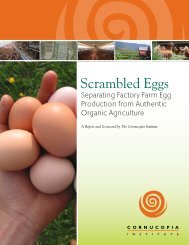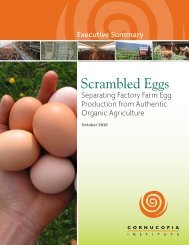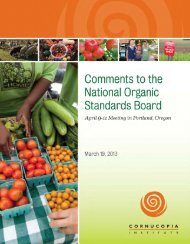“Behind the Bean” (pdf) - Cornucopia Institute
“Behind the Bean” (pdf) - Cornucopia Institute
“Behind the Bean” (pdf) - Cornucopia Institute
You also want an ePaper? Increase the reach of your titles
YUMPU automatically turns print PDFs into web optimized ePapers that Google loves.
administration officials at <strong>the</strong> USDA did not step in to compel QAI and o<strong>the</strong>r certifiers to enforce <strong>the</strong> standards.<br />
The only way to ensure that all organic foods contain organic lecithin is to remove lecithin as an approved conventional<br />
substance on <strong>the</strong> National List. Clarkson Grain filed a petition with <strong>the</strong> USDA to remove soy lecithin, and <strong>the</strong> National<br />
Organic Standards Board, at its May 2009 meeting, voted in favor of <strong>the</strong> petition. Unfortunately, due to corporate pressure,<br />
<strong>the</strong> National Organic Standards Board voted to keep “de-oiled” (dry) lecithin on <strong>the</strong> list.<br />
There are two types of lecithin, liquid and de-oiled. De-oiled lecithin is not yet available in organic form, because an organic<br />
alternative to using <strong>the</strong> solvent acetone, in <strong>the</strong> de-oiling process, has not been developed.<br />
Since acetone can be harmful to workers when inhaled, potentially leading to irritation, headache, blurred vision and narcosis,<br />
100 <strong>the</strong> Occupational Safety and Health Administration (OSHA) has set a maximum concentration limit in workplace air<br />
of 1,000 ppm of air for an 8-hour workday over a 40-hour week to protect workers. 101 According to <strong>the</strong> Centers for Disease<br />
Control, ingesting small amounts of acetone, such as through residues on food, is not harmful, but <strong>the</strong> effects of long-term<br />
exposures have not been studied in people. 102 In animal studies, long-term exposure to acetone was linked to kidney, liver<br />
and nerve damage, as well as increased birth defects. 103 Unlike hexane, acetone is not listed as a hazardous air pollutant<br />
with <strong>the</strong> EPA. 104<br />
It has been suggested that <strong>the</strong> choice to use de-oiled lecithin is one of convenience for <strong>the</strong> manufacturer; if a company is<br />
truly committed to organic integrity, it can find a way to use liquid organic lecithin even in dry foods such as powdered<br />
infant formula. In addition to being processed with acetone, <strong>the</strong> conventional “de-oiled” lecithin that will remain allowed<br />
in organic food will be made with conventionally grown soybeans and extracted with <strong>the</strong> use of hexane.<br />
Since this was <strong>the</strong> first time that <strong>the</strong> National Organic Standards Board considered a petition to remove a food ingredient<br />
from <strong>the</strong> list, this 2009 vote set a precedent with regard to <strong>the</strong> NOSB’s willingness to remove ingredients from <strong>the</strong> National<br />
List when organic alternatives become available. Their decision to keep de-oiled lecithin on <strong>the</strong> List, however, is disappointing<br />
since it is hexane- and acetone-extracted and is chosen over <strong>the</strong> liquid form primarily as a matter of convenience<br />
for food manufacturers.<br />
Organic consumers expect foods that were produced in a more environmentally and socially responsible way—and realize<br />
that this often means that farmers and food processors must sacrifice some convenience in <strong>the</strong> quest for producing food<br />
sustainably. Moreover, organic consumers expect <strong>the</strong> green “USDA certified organic” label to reflect this commitment to an<br />
alternative food production system where low cost is not <strong>the</strong> top priority. Keeping hexane- and acetone-extracted de-oiled<br />
lecithin on <strong>the</strong> National List indicates a fur<strong>the</strong>r erosion of <strong>the</strong> integrity of <strong>the</strong> national organic standards. The <strong>Cornucopia</strong><br />
<strong>Institute</strong>, and our allies, will continue to highlight concerns involving syn<strong>the</strong>tic and nonorganic ingredients inappropriately<br />
utilized in organic production.<br />
Since organic soy lecithin is available but more expensive, checking an ingredients label for organic soy lecithin is a great<br />
way to determine how committed a company is to organics. If a company uses organic soy lecithin, <strong>the</strong>y are paying more, in<br />
return for a more truly organic product. They show <strong>the</strong>ir commitment to organics and <strong>the</strong>ir support to <strong>the</strong> companies that<br />
are pioneers in developing ingredients that are organic. Consumers should be aware of this issue so that <strong>the</strong>y can support<br />
<strong>the</strong>se companies in <strong>the</strong> marketplace.<br />
40 Behind <strong>the</strong> bean: The Heroes and Charlatans of <strong>the</strong> Natural and Organic Soy Foods Industry.





